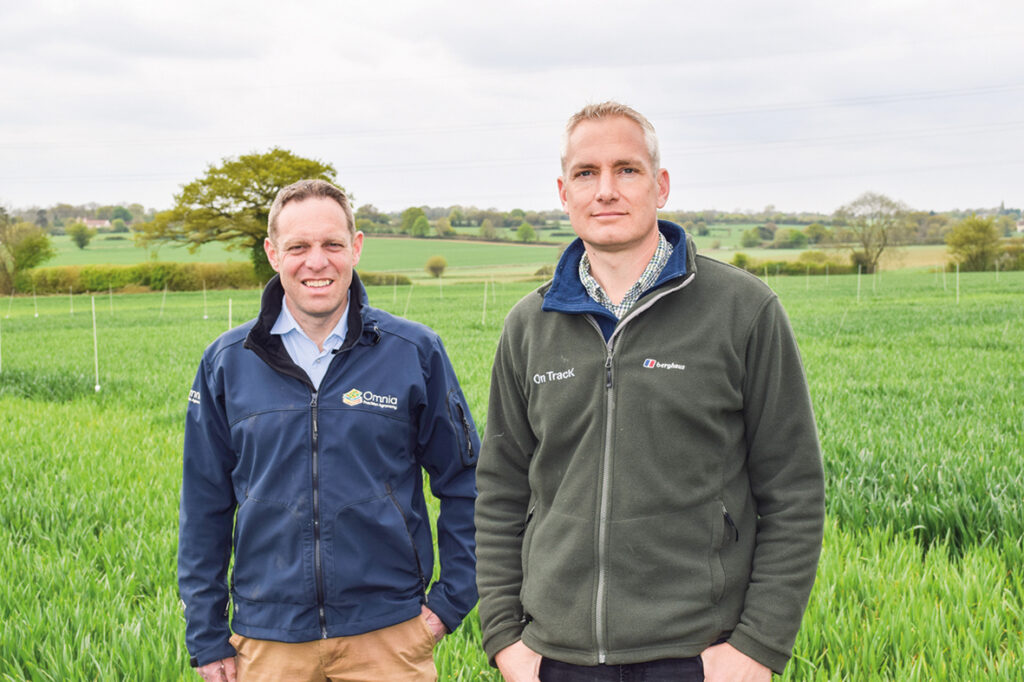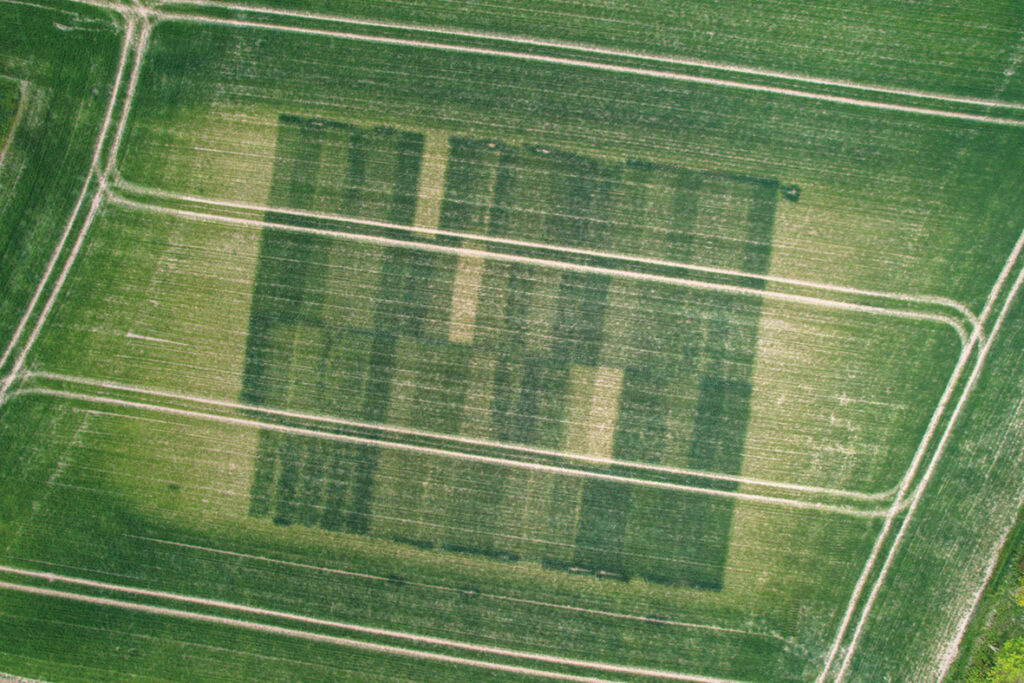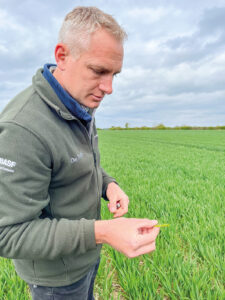Farm scale trials: Adding value financially and environmentally to the farm business
1st June 2022
Hutchinsons Helix farms provide a regional ‘test-bed’ for ideas and technologies which are generated through the national Helix programme. Rachel Hicks visited Helix East Anglia in May to discuss the current focuses, including nutrient usage efficiency, wheat blends and endophyte seed treatments.

Hutchinsons Helix East Anglia manager, Rob Jewers, with Tom Jewers of G D Jewers & Son at Wood Hall Farm in Rattlesden, which hosts Helix East Anglia.
The Helix programme is designed to test out new and developing technologies and concepts that are coming to the market based on small-scale trials, to ascertain the margin over input cost on a farm scale. There are seven Helix farms around the country, including the original National Helix site in Northamptonshire (launched in 2019), which conduct the testing across the differing microclimates of each area.
Tom Jewers of G D Jewers & Son at Wood Hall Farm in Rattlesden hosts Helix East Anglia, where Mr Jewers is able to test new technologies and approaches on his own farm – at no risk to him.
G D Jewers is a family-run farm, just shy of 400ha all told. Approximately half is owned, the rest is contract-farmed. Part of the farm is in the Countryside Stewardship Mid-Tier scheme, and has a particular focus on soil health and sustainable crop rotations, which includes extensive use of multi-species cover, catch and companion crops in a direct drilling system.
Most of the farm is medium-bodied Hanslope series clay loam, which behaves more like heavy land, so these cover crops are key to improving soil health and resilience. They have also proved invaluable for facilitating autumn and spring drilling, especially in wet seasons.
The farm’s current rotation is fairly long, at 8/9 years. It generally goes winter barley, oilseed rape, two wheats, a spring barley, and then either winter beans or something more “exotic and niche” such as buckwheat, vetch and mustard, as a seed contract crop in order to extend the rotation. Then another wheat, spring barley, winter barley, and back into OSR again.
The Helix fields were all scanned into Hutchinsons’ TerraMap, which forms part of the Omnia precision farming system. This allows Tom and Rob to record and assess the soil textural properties and nutritional elements across the various trial fields, as well as mapping the carbon due to the new TerraMap Carbon option. This service can map up to 27 layers (for the premium option), including total organic and active carbon percentage and tonnes/ha, as well as various micronutrient, soil type and pH layers.
Experiments without risk
Around 50ha is used for Helix, but this is highly flexible – if Mr Jewers thinks there’s a trial that is worthwhile doing, he will try to fit it in somewhere where possible.
This year, the primary focus is nutrient usage efficiency; for example, they are trialling different products which claim to extract nitrogen from the air and help fix it from the air, as well as from the soil – including different seed treatments and foliar treatments, be it bacterias, endophytes, as well as investigating the effects of foliar nitrogen; with the overall aim to reduce spend on nitrogen given the current financial impact as well as with a view to reducing the carbon footprint. These are being tested out against farm standards.
Tom is also doing some work on phosphate deficiency, to see if he can improve phosphate uptake – which is a particular issue on the farm at Rattlesden with high salt index sources such as TSP instantly locking up on the farm’s high pH soils.
So he and Rob are trying different ways of getting phosphate in the plant more efficiently and economically.
They’re also experimenting with blends of cereal varieties, both in terms of whether it impacts on nutrient uptake, and the disease prevention as a result of having different varieties within the same field. The farm also regularly runs trials on different cover crops, as well as the companion cropping in oilseed rape.
NUE and N response
Tom and Rob are currently undertaking nitrogen response work in collaboration with Yara – in particular assessing the impact (financial and environmental) of varying nitrogen rates from zero to around 340kg N/ha (with three or four different rates being applied) on Astronomer, which was drilled at the end of September. Various tools such as tissue testing, Yara N-Tester, chlorophyll meter measurements, grain nutrient analysis and NDVI analysis are being used in this
work, alongside thorough crop and yield assessments throughout the season. The work is also examining whether inhibitors affect soil microbiology, by inhibiting the activity of bacteria involved in the nitrogen cycle.
A baseline assessment of chemical, physical and biological soil properties was taken at the start of the season and further tests are being done to identify any impact on soil health.
A further trial is looking at different nitrogen timings, as Tom Jewers has concerns that in very dry springs, crops are not taking up granular fertiliser efficiently. The traditional granular approach is being trialled against foliar-applied N later in the season and through dry spring weather.
Improving phosphate use efficiency is another key area, especially as Hutchinsons grain samplings have shown low/marginal P to be an issue in many crops nationally – although this is often due to plant availability rather than low soil indices, which is where placing fertiliser should help. “Phosphate is easily locked up by calcium, magnesium and aluminium in the soil, which means crops cannot access it,” notes Rob Jewers. “Additionally, triple super phosphate (TSP) has just 10% use efficiency, compared with nitrogen’s 60%.”
A separate tramline trial involving Skyscraper is also testing whether a novel endophyte seed treatment, Tiros, could help crops fix nitrogen, sequester phosphate, potassium and zinc, and improve drought tolerance. While results of this are not yet obvious, Tom Jewers said initial observations suggest the tillering and stem thickness are possibly improved – although stem extension had only just begun at that time, so results will be reported later in the year.

The drone image shows the nitrogen response trials from above, where there are clear differences in the strip plots.
Building disease resilience
Another focus area is a field-scale trial investigating whether sowing 3-way and 4-way blends of different wheat varieties can improve crop resilience to pests and diseases – spreading the risk from a resistance breakdown perspective. There’s a lot of anecdotal evidence around this, so Tom is considering cutting the fungicides on one field, and using a full programme on the other to see how wheat blends can be used in the future. “Increasing genetic diversity helps us reduce the risk of a disease like rust sweeping across a whole field. The blend should be more resilient, and there may be scope to reduce our input spend,” he says.
When it comes to choosing blends, it’s important to choose the varieties carefully – both in terms of the end market, as milling blends are rather niche, whereas the feed market is less fussy; and also looking ahead to harvest. While varieties may take off at different times, the key is to blend varieties which mature at the same time, and which will be comparable height-wise.
As blends don’t come with a thousand grain weight, drilling rates are a slightly unknown quantity. As such, Tom opted to drill at the same seed rate rather than per kg.
Hutchinsons is also interested in how using wheat blends can impact on nutrient usage, and will be looking at shoot counts, biomass counts, tissue and sap testing as well as grain analysis to see what nutrition has been brought through into the grain.
The wheat blends were sown on 14th October. No T0 was applied, just some PGR, and it received a litre of Revystar at T1 as septoria was apparent over the winter and one area Tom says he never skimps on is disease control at T1. In his opinion, if you can control the disease at T1, you can earn the right to cut back at T2 if the weather is conducive to it – but doing the same at the T1 timing is far more risky.
OSR pest issues
This year, the farm has experienced significant OSR pest issues, with the crop having really suffered from larval damage. But it’s not been cabbage stem flea beetle; to Mr Jewers’ surprise, it has been caused by rape winter stem weevil – a pest he hadn’t really come across before, which appears to have come down from Scotland. It absolutely devastated some of the winter OSR, to the point where he has pulled up 9ha this spring, and reseeded it with spring OSR in the hope he can take advantage of the current commodity price. To him, this is a real concern for the future, as it’s not a pest which is very apparent in the autumn – they tend to stay in the petiole, but Mr Jewers believes the pigeons, which have also been causing a significant problem, have driven the larvae into the centre stem where the pigeons have taken off the outer leaves, and this has caused the greatest damage. Where there has been no pigeon problem, the larvae have stayed in the outer petioles and haven’t really caused much of an issue.
Last year, G D Jewers & Son grew buckwheat as well as some phacelia on a seed contract for local company, Walnes Seeds, which Mr Jewers says they’ll be doing again this year. They’ll also be trying vetch alongside mustard, using the mustard as a sort of trellis to support the vetch which has a habit of going flat, making it difficult to combine. A small area of this will be trialled to see how it goes, as it’s becoming more and more difficult to get hold of these types of cover crops varieties in the UK particularly with the current issues in Ukraine and Russia.

